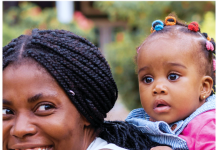By Sharon Atieno
In 2023, 18-year-old Claire Njeri* lost her baby. The baby had suffered from asphyxia – a condition where the body doesn’t get enough oxygen, leading to unconsciousness and potentially death.
At just 16, Njeri went to a health facility in Baba Dogo, Nairobi, to give birth, but on arrival, nurses told her she had not dilated enough and the baby was not ready.
As she writhed in pain on the hospital bed, she felt the baby coming – but she had been left alone and didn’t know what to do. It had been eight long hours (from 8.00 am to 4.00 pm), and she was exhausted. Had it not been for her mother’s intervention, questioning why she had been left unattended, the nurses might not have come.
The nurses and doctor who finally attended to her kept yelling at her to push. She was already pushing, but the baby was not coming out.
“Huyu anaogopa kupush (she fears pushing),” one of the nurses told her aunt.
After birth, the baby struggled to breathe, and Njeri’s mother requested a referral to Pumwani Maternity Hospital. There, the baby was immediately put on oxygen but died shortly after.
Njeri’s experience reflects a wider pattern of mistreatment that many women and adolescents face during childbirth.
Obstetric violence: A local and global concern
Obstetric violence, the mistreatment and abuse of women during childbirth in healthcare facilities, is a global concern. It includes forced medical procedures, non-consensual interventions, disrespectful language, neglect, and discrimination based on socioeconomic status, ethnicity, or gender identity.
A World Health Organisation (WHO) study in Ghana, Guinea, Myanmar and Nigeria found that over a third of women reported such mistreatment, with the highest risk of verbal and physical abuse occurring in the 30 minutes before birth and 15 minutes after delivery. Younger, less-educated women were particularly vulnerable.
In Kenya, a 2023 study conducted in Korogocho, an informal settlement in Nairobi, documented mistreatment of teenage mothers seeking maternity care. Nearly one in three experienced verbal abuse from health providers, 15% experienced stigma and discrimination, and some reported physical abuse. One in ten reported neglect and abandonment during childbirth, 17% were detained due to inability to pay, and about a quarter (24%) reported a lack of privacy.
Dr. Anthony Ajayi, the study’s lead author and a research scientist at the African Population and Health Research Centre (APHRC), said such mistreatment erodes trust and discourages adolescents from giving birth in clinics or recommending them to peers. It is also associated with negative birth outcomes.
Teenage pregnancies carry higher health risks for both mother and baby. According to the United Nations Population Fund (UNFPA), girls and young women aged 15 to 19 are twice as likely to die from maternal causes as women in their 20s. Those aged 10 to 14 are five times more likely to die than women aged 20 to 24.
Adolescents also face higher risks of complications like eclampsia, obstructed labour and reproductive tract infections. Their babies are more likely to be born prematurely, underweight or with severe complications. Mental health issues like depression are also common among pregnant adolescents.
Barriers to care
Community health promoters (CHPs) like Eunice Lanya in Dandora, Nairobi, play a vital role in reaching adolescents who might otherwise fall through the cracks.
“Some got pregnant unexpectedly, while others suffer from rejection, leading to self-stigma and isolation; hence, they do not want to visit health facilities. Others fear being judged by the healthcare providers,” she explains.
Lanya ensures that pregnant teenagers attend antenatal clinics and their babies receive routine check-ups and immunisations.
“I go door to door checking if the teen mothers have visited a health facility. I ask to see their clinic books because some tell you they’ve gone, yet they’ve not. Some are resistant; they don’t even want to talk to you or find out how you can help them. Others are very responsive,” she says.
Burden of teen pregnancy
Kenya bears a significant burden of teenage pregnancies. According to the 2022 Kenya Demographic and Health Survey, 15% of girls aged 15-19 have been pregnant, and the rate rises with age, from 3% among 15-year-olds to 31% among 19-year-olds. Poverty plays a role, with 21% of girls in the lowest wealth quintile having been pregnant, compared to 8% in the highest quintile.
Dr. Ajayi stresses the need for adolescent-friendly health services to ensure positive birth outcomes.
“Adolescent-friendly facilities are welcoming to adolescents irrespective of their socioeconomic or marital status. They do not abuse them verbally, physically, or emotionally. They do not detain them for inability to pay. They offer privacy and professional care,” he says.
Without such services, adolescents remain vulnerable: “It means adolescents will seek alternative care from the backstreet, leading to complications and even deaths.”
Community-based interventions
Kenya’s National Guidelines for Provision of Adolescent and Youth-Friendly Services echo this need, emphasising that services must be non-judgemental, appealing, respectful and accessible to ensure that adolescents feel informed, welcome and safe.
A 2023 report assessing adolescent-friendly health services in Marsabit, Mandera and Isiolo, where teen pregnancy rates stand at 29.4%, 14% and 17%, respectively, found that 67% of the facilities had dedicated staff for adolescent sexual and reproductive health services. Additionally, 93% offered walk-in services without a formal appointment, and 90% had private examination rooms.
Though not part of the study, one such adolescent-friendly clinic is Mwangaza Ulio na Tumaini Clinic, a faith-based facility in Korogocho. It provides antenatal, maternity, and family planning services to teenage mothers. The clinic runs mentorship days every Tuesday and Thursday, offering vocational training in skills such as hairdressing, nail art, soap making, carpet weaving and beadwork. These sessions are designed for teenagers who are not returning to school, equipping them with practical skills to earn a living.
Most of the nurses at the facility are young, and the staff undergoes youth-friendly training whenever such programmes are available. The clinic conducts continuous monitoring and weekly training on how to support teenagers and other patients.
According to Millicent Omwande, the nurse in charge, most of the teenage mothers are between 16 and 19 years old, with a few as young as 14 or 15.
“We offer youth-friendly services, and we don’t charge for them. Most teens like getting services where they are not judged or asked intrusive questions like, ‘Why are you pregnant when you’re supposed to be in school?’” says Omwande. She adds that building trust with the teenagers is a priority.
“When I talk to them, I am not just a nurse; I am a sister, a mother and a friend. When you connect all these roles, they feel welcomed.”
Omwande says that most teenagers come through referrals, drawn by how their peers are treated. Some even ask if they can bring a pregnant friend along on their next visit.
Each month, the hospital provides antenatal care to about 20 teenagers and delivery services to 10.
One of the teenage mothers who received care at the clinic is Faiza Achieng, who is now 21. When she became pregnant four years ago, she was 17 and in her final year of high school. Ashamed and afraid, she considered terminating the pregnancy. But her mother and a doctor at the Mwangaza Ulio na Tumaini Clinic changed her mind.
“The doctor was so kind; she encouraged me every step of the way. She assured me that the baby would not only be well but that he would grow up and go to school, and I would also go back to school and finish my education,” Achieng recalls, smiling.
Her son is now four and has started school. Achieng completed high school and now works at a local restaurant.

Other facilities in the area, such as Ruaraka Neema Uhai Hospital, also offer adolescent-friendly care. The hospital runs a teen mothers’ programme, working with community health promoters (CHPs) to identify pregnant teenagers in Korogocho, Mathare and Kariobangi. The programme provides counselling, antenatal care, pregnancy and parenting education, and vocational skills such as braiding and tailoring.
Jane Atieno*, 16, found help at this clinic. When she first discovered she was pregnant, she refused to go to the hospital despite her mother’s constant advice. She feared being discriminated against and being asked intrusive questions like, “Who impregnated this young girl?” or “Who are you living with?”
She changed her mind after learning about the hospital’s teen-friendly initiative from a CHP.
At the facility, she found other teenagers like her, a welcoming environment, counselling and designated clinic days just for teens.
While some facilities have well-established adolescent-friendly services, others struggle to sustain them. The Korogocho Health Centre, for example, previously operated a youth-friendly desk with dedicated staff to welcome and guide young patients, with support from a local non-governmental organisation. However, since the staff’s contract ended, the desk remains unmanned, forcing adolescents to queue with other patients.
These models highlight the importance of consistency, showing that when services are tailored and respectful, adolescent girls are more likely to seek care, improving outcomes for themselves and their babies.
Gaps and solutions
While there has been progress, adolescent-friendly care is not universal. A 2023 Health Action International report found that although 60% of public health facilities were accredited as adolescent-friendly and 65% offered sexual and reproductive health services for adolescents, only 13% involved adolescents in designing or evaluating those services, highlighting a critical gap in ensuring services truly meet their needs.
Even where services exist, operational barriers persist. Many facilities close by 5.00 pm and don’t operate on weekends and evenings, limiting access for teens who may be in school or working. Few employ youthful staff who might relate better to adolescents, and many rely on short-term or inconsistent funding, and once the funding ends, the services stop.
Without sustained investment and stronger national accountability, efforts remain fragmented, leaving adolescents without the care they need.
Scaling up successful models requires both political commitment and budgetary prioritisation to ensure adolescent-friendly services become the norm. Evaluations show that competent health providers alone are not enough to increase youth access to sexual and reproductive health services. Complementary approaches are essential: providers must be trained and supported to offer non-judgemental, youth-friendly care, and health facilities must be welcoming and appealing. Communication and outreach are also key to informing young people about available services and encouraging them to seek care. Community support is equally critical in helping adolescents access the care they need.
Access to timely and respectful maternal health services such as antenatal care, skilled delivery and postnatal care is essential to preventing deaths among teenage mothers and their babies. This can only happen through the implementation of truly adolescent-friendly health services.
* Names have been changed
This article was produced with the support of Africa Women’s Journalism Project (AWJP).







